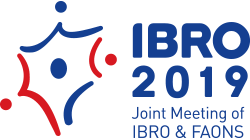Scientific Program
Program & Abstract Search
Home > Scientific Program > Program & Abstract Search
Luncheon Seminar
- Organized by GNT Pharma
- Date Sat. (Sep. 21) 12:00 ~ 13:30
- Room 325, 3F
- Title Breakthroughs in Stroke and Alzheimer’s Disease Treatment
- Speaker BYOUNG JOO GWAG, Ph.D. CEO, GNT Pharma / JIN HWAN LEE, Ph.D. GNT Pharma
Brief Description
Sponsored by GNT Pharma
GNT Pharma is pleased to share breakthrough translational challenge for the development of stroke and Alzheimer’s disease treatment.
Part I: Nelonmedaz: a breakthrough therapy for stroke
Nelonemdaz (Neu2000) is a multi-target neuroprotectant preventing both the NMDA receptor and free radicals, two major routes of brain cell death following stroke attack. Nelonemdaz shows excellent efficacy in 4 different animal models of stroke. The efficacy and safety of nelonemdaz are superior to conventional NMDS receptor antagonists and antioxidants. Its safety has been proven through Human phase I clinical test in the US (95 healthy subjects) and also in China (70 healthy subjects) with treatment index = 30-800 times depending on the stroke type.
Two Phase II Clinical trials for stroke patients have been conducted in China (ENIS II trial) and South Korea (SONIC II trial). The ENIS II trial has been successfully completed for 238 patients in July 2019. The SONIC II trial is the first clinical trial for acute ischemic stroke patients receiving endovascular treatment and has successfully enrolled 164 patients.
Part II: Crisdesalazine: a new hope for Alzheimer’s disease
Crisdesalazine (AAD-2004) prevents both free radicals and PGE2-(microsomal prostaglandin E synthase-1) mediated inflammation, which are the key pathological mediators of neuronal death in Alzheimer’s disease (AD).
Nearly all AD drug candidates show beneficial effects in transgenic mouse models of AD but sad to say have failed in clinical trials over the decades. To overcome the limit of the mouse models, we explored a new translational road to connect canine cognitive dysfunction syndrome (CCDS) that is accompanied by histopathological features of amyloid plaques, neuronal loss, and neurofibrillary tangles very similar to AD. We conducted a pilot clinical study to examine if crisdesalazine would show beneficial effects in dogs with severe CDS. Oral administration of crisdesalazine for 8 weeks remarkably improved cognitive function and daily activity in companion dogs with severe CDS, also showing disease-modifying effect. A phase III study (SMART trial) of crisdesalazine for CCDS is ongoing and expected to complete by the end of 2019. CCDS as well as mouse models will pave a new way for better translation of AD drugs.
* Registration is not required



